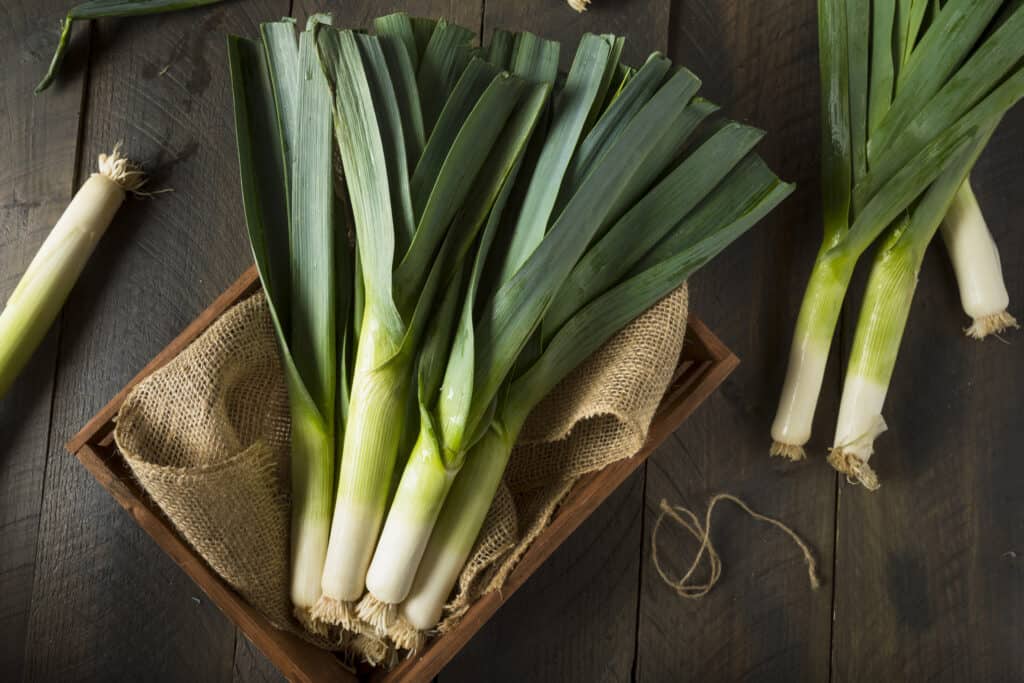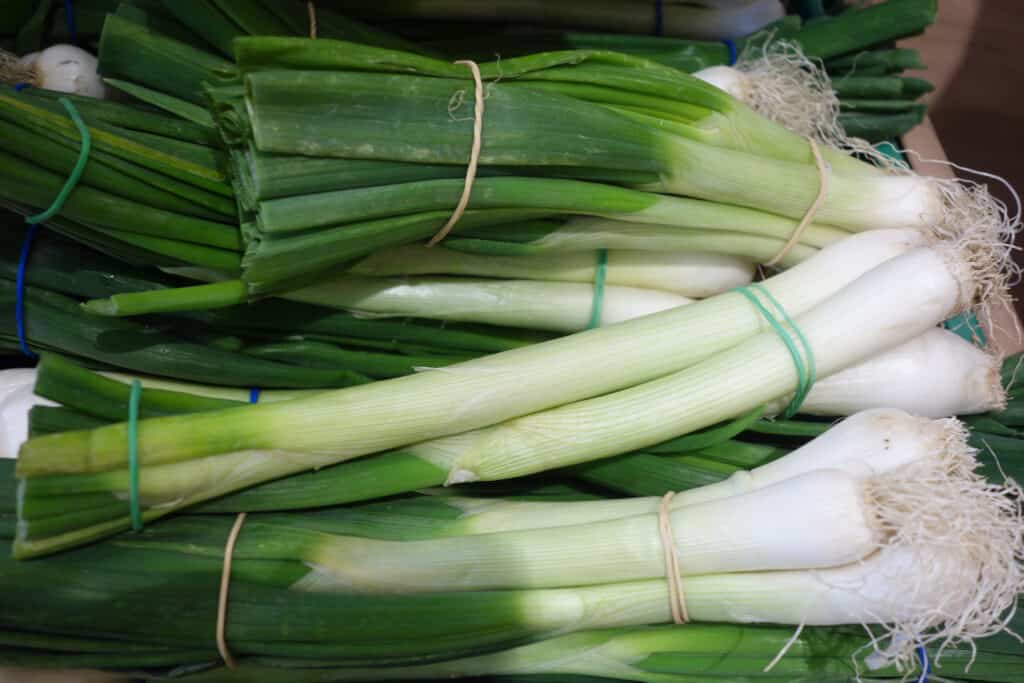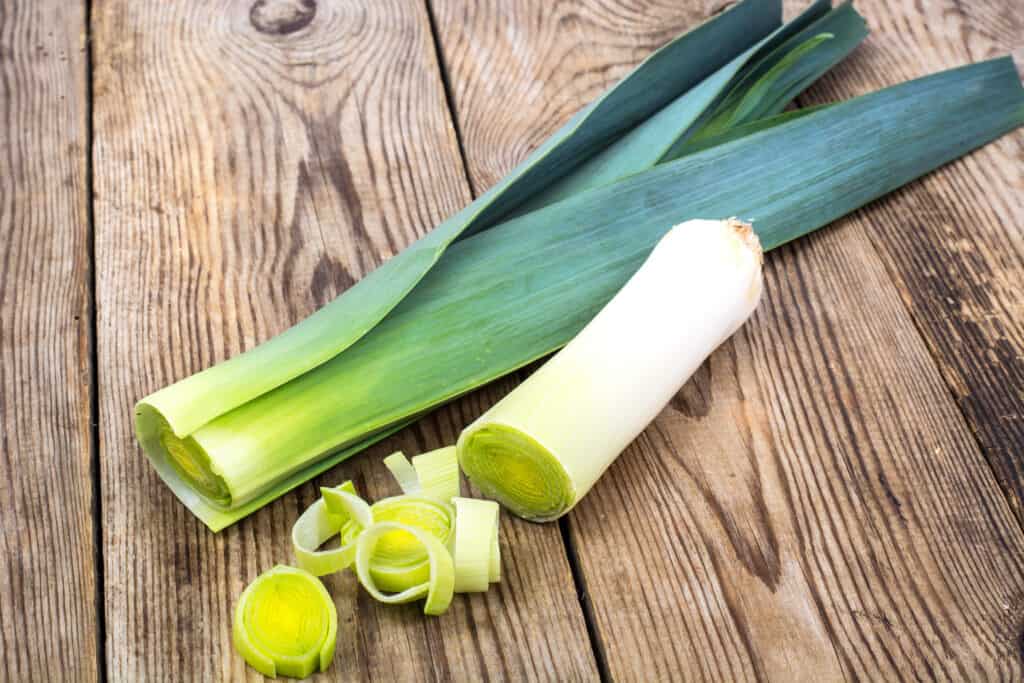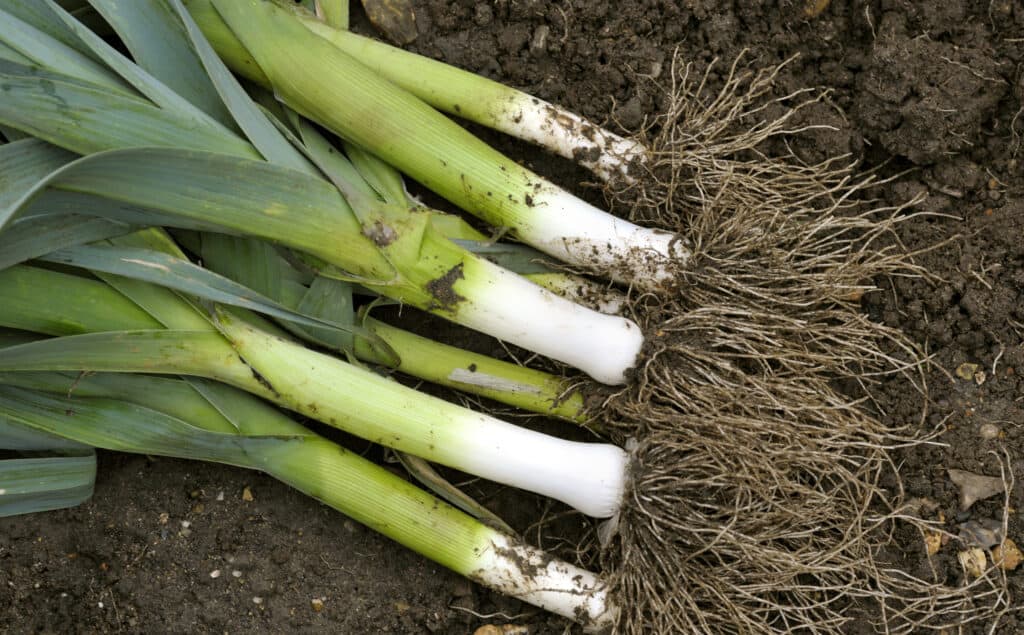Leek and Green onions are both members of the Allium family, but when compared, the two vegetables have many differences. From variations in taste and texture to the individual uses for the crop in the kitchen, the two plants have separate origins, contrasting growing cycles, and unique flavors and appearances. What are some other differences between leek and green onion?
Leek vs. Green Onion: A Quick Look
Leek vs. Green Onion: Classification
Different varieties of the leek are classified according to the length of the white base, resulting in short, long, and semi-long varieties. Also organized by growing season, they can be further separated into summer, autumn, and winter leek. Summer leeks are smaller, tender, and smooth stalked, with a fresh crispy taste, while winter versions are thicker, woodier, and more robust.
Many references to green onions are actually referring to immature plants of the common onion rather than a separate species themselves. The defining characteristic of green onions is the deep green and slender hallow stalks and lack of a developed bulb.
Leek vs. Green Onion: Key Differences in Appearance
Leeks are thick-stemmed, light green stalks, 6-12 inches long, and cylindrical with no defined bulb. The leaves are sheath-like and layered tightly onto bulky stems. They resemble oversized, overgrown green onions. Leek flowers are miniature, purple, and white, which cluster to form a large round ball, scented sweetly of mild garlic.
Green onions are smaller, around 6-8 inches, and slender, not layered, with deeper green hollow leaves and a slightly bulging spherical white bulb. White stringy roots are often still attached at the point of purchase. Spring onion flowers are small, white, and delicately fragranced.

Brent Hofacker/Shutterstock.com
Leek vs. Green Onion: Origin
Leeks are native to the Middle East and Mediterranean regions. A popular foodstuff in Ancient Egypt, archaeological digs confirm the presence of the vegetable in the Valley of the Kings for over four millennia. The leek was introduced to Europe by Roman Empire soldiers and brought to North America with early European settlers where its hardy nature meant it was a valuable, versatile crop.
Green onions are thought to have originated in Asia, but due to the vegetable being highly perishable and the fact that cultivating onions leaves little trace, food historians have trouble pinpointing the exact origin or history of the plant. We do know that onions were grown and eaten by Ancient Egyptians over 5,500 years ago.
Leek vs. Green Onion: Nutritional Information
Leeks are nutritious garden vegetables. The fresh green stalks are proven to reduce cholesterol and contain antibacterial, antiviral, and antifungal properties, they are low calorie, high in antioxidants, and a great source of soluble and insoluble fiber. Full of folates, essential for cell division, and vitamins such as A, C, K, and E, known to help the immune system develop resistance against infection.
Green onions are also an excellent source of folates, supplying over 10% of the recommended daily allowance in one serving. As an abundant source of vitamin C and a low-calorie vegetable, green onions are a rich source of chromium which helps regulate insulin levels and manage diabetes. Green onions are a nutritious and decorative garnish for most dishes!

iStock.com/Elmar Gubisch
Leek vs. Green Onion: Taste
The taste of a leek is described as mild and earthy. The edible part of the leek is known as the stem or stalk. Leeks are crunchy and fresh when eaten raw but are usually chopped into bite-sized chunks and sautéed in butter, baked, or boiled to soften the leaves and transform the flavor. Cooking leek imbues a sweet tang. The leek is known as a more refined taste than an onion.
Green onions or scallions are popular in salads due to the fresh sharp taste of the bright green stalks and more pungent onion flavored bulb. Much milder than a standard onion, the scallion is delicious raw, served as a crudité with other raw vegetables like carrots and celery, and accompanied by dips such as ranch dressing or hummus.

iStock.com/ArtCookStudio
Leek vs. Green Onion: Uses
Due to its tender sweet bite, leek is a common ingredient in soups and stews. Add chopped and sautéed leek to mashed potato for a warming side dish, slice thinly and include in a fresh salad, or use leek in place of celery with onion and carrot for an all-encompassing base to impart flavor to casseroles, stir fry, curries, and many other dishes.
Green onions are best enjoyed raw in salads, sandwiches, and as a garnish. Mix into mashed potato for a twist on traditional colcannon, combine with natural yogurt for a creamy, zingy dip, or layer with sharp cheddar and parmesan on flaky pastry for an open cheese and onion tart. Scallions can withstand some heat and work well with Asian tastes like Mongolian beef and chicken, and ginger dishes.
Leek vs. Green Onion: Related Plants
Other members of the Allium family include chive, garlic, shallot, and Chinese onion, although the genus comprises hundreds of species. Some are edible, some ornamental, and many grow wild in the Northern Hemisphere. Alliums are distinctive for their garlicky/oniony scent due in part to their long foliage. Known as basal foliage, the term refers to the plant’s growth pattern, with long stems originating from the base, ensuring the branches provide protection to the plant and making them difficult to pull up individually, which may deter predators. The term Allium may come from the Greek word ‘to avoid’ due to its pungent smell and disagreeable raw taste.
Leek vs. Green Onion: How to Grow
Leek should be sown indoors in trays for the best start. Transplant at 6-8 weeks or when the seedling is 6 inches tall. Dig a shallow trench in well-drained, sunlit soil and space the seedlings 4-6 inches apart. Mounding, or pilling excavated soil around the plant stem in its infancy, will block out light, protect the seedling, and encourage strong growth in the plant. This technique, similar to celery blanching, prevents a bitter taste familiar in leek. Leek plants take up to 6 months to fully develop; harvesting may begin when the plants are shaped like thick pencils.
Green onion seeds should be sown in trays and transplanted as seedlings into fertilized, well-drained soil. When transplanted into deep drills, watered well, and exposed to enough sunlight, green onions will be ready to harvest in just two months when stalks are deep green and bulbs 0.5 inches in diameter or less. Using successional growing, they can crop all year round, but the vegetable is at its best in spring, hence the moniker spring onions.

iStock.com/Zoya2222
Leek vs. Green Onion: Varieties
Leeks have been bred for hardiness and improved reaction to climatic changes. Some popular varieties of the leek are Musselburgh and Almera. King Richard Leek is perfect for shorter growing seasons. Below zero varieties are bred to withstand the harshest of British weather. Giant Winter and Pot leek both produce large, heavy vegetables.
Green onion varieties are selected for speedy growth, mild and sweet taste, and coloring. White Lisbon is a fast-growing, winter-hardy crop, while Ramrod produces stiff green stalks of deep green. Purple-skinned varieties such as Apache and red-bulbed spring onions like North Holland Blood Red have grown in popularity for the unusually bright colors they bring to the table.
Leek vs. Green Onion: Storage and Preparation
Both vegetables are highly perishable fresh produce. This means they begin to degrade and lose nutritional value immediately after harvest. Conversely, green onion can continue to grow until required. Both should be refrigerated after purchase and used within ten days for maximum taste and nutrition.
Leek is tougher and less delicate than green onions, but soil and other contaminants collect between the layers as they grow. Therefore, it is always advised to wash leeks carefully prior to use, taking care to rinse between tough green skins until the water runs clear. Leek should be stored in the refrigerator in a sealed box or bag.
Green onions may be stored on the windowsill with their roots in a little water, extending their life and making them more useful in the kitchen. Clipping a portion of the green stalks to eat every couple of days will ensure the scallion regrows. This technique can provide more fresh green onions for your money! Otherwise, rinse the onions and store in a sealed box or bag.

iStock.com/Grahamphoto23
Leek vs. Green Onion: Fun Facts
The leek is the country of Wales’s national emblem, serving as a good luck emblem and is proudly worn on lapels on the country’s national celebration of St David’s Day.
Green onions are often referred to as scallions, a Gaelic word which comes from the word ‘shallot,’ meaning ‘thing of little value.’ How inapt for a garden vegetable that grows quickly and easily and provides valuable nutrition!
Roman Emperor Nero was given the nickname ‘Leek-eater’ due to his love of the woody vegetable, which he reportedly consumed raw, believing they would improve the quality of his voice. Aristotle maintained a similar devotion to the leek and, in particular, its health benefits.
The green onion, called Cong Bai in Chinese, has a rich history as a health remedy in holistic medicine. The bulb is used to treat the common cold and fight bacterial or fungal infections. Every part of the green onion is used from root to seed; the bulb is juiced with ginger and salt to form a healing poultice. The therapeutic effects are attributed to the plant’s volatile oils, a property that unites Allium family members.
Farfetch’d, the avian Pokémon that resembles a brown duck, carries a leek at all times. Used as a nesting material, a food source, and an unlikely weapon, the elusive anime poultry may lose energy and die without his woody stalked Allium by his side.
Green onions grow so fast they mostly avoid pest infestation and damage from disease, making them an easy allotment crop for the green-fingered vegetable gardener. They also grow well in repurposed plastic bottles and window boxes.
Wild leek, a cross between garlic, green onions, and commercially cultivated leek, is found all over the US and is commonly known as ramps. Ramps are a firm favorite with foragers due to their strong taste, pungent scent, and versatility. The green leaves are a welcome sign of spring in Appalachia, where they thrive, and in Richwood, West Virginia, the self-titled ‘Ramp Capital of the World.’

iStock.com/Dumitru Ochievschi
Leek vs. Green Onion: Pests and Disease
As mentioned, green onion is less susceptible to disease and pests due to the plant’s swift growth cycle of around 2-3 months. However, all Allium family members can be vulnerable to two common pests: downy mildew and onion white rot.
Downy mildew is a fungal disease that causes blotches to appear on the leaves, and the plant may suffer stunted growth. To avoid downy mildew, ensure enough space between plants to allow for better air circulation and water only in the morning before the sun is high. Onion white rot is a fungus transferred from infected soil, which can rot the bulb of the onion and render it inedible. Crop rotation is a valuable tool to reduce the instance of rot as chemical solutions to the fungus are not forthcoming.
Leek vs. Green Onion: Does Chopping Them Make You Cry?
Onions are famous for making you cry, but does this apply to leek and green onions? When sliced open, onions release a gas called syn-propanethial S-oxide. This gas reacts with the moisture in your eyes to form sulfuric acid, which causes the stinging sensation that brings on involuntary tears. Luckily, chopping leek or green onions is unlikely to generate the same level of gas emitted.
Leek vs. Green Onion: Overview
As we can see, even though both vegetables are members of the Allium family, there are some differences between leek and green onions. While scallions add a bright, delicious bite when served raw, leek should be cooked to improve its woody texture. Both are healthy, nutritious additions to many traditional meals and vegetable-based snacks. As a bonus, slicing into fresh leek or green onions won’t make you cry. No more tears!
Up Next
- Chives vs Green Onions: Is There a Difference?
- Chives vs Scallions: What’s the Difference?
- 19 Vegetables to Plant in September
The post Leek vs. Green Onion What Are the Differences? appeared first on AZ Animals.
from Animal News, Facts, Rankings, and More! - AZ Animals https://ift.tt/Aek7Dl3